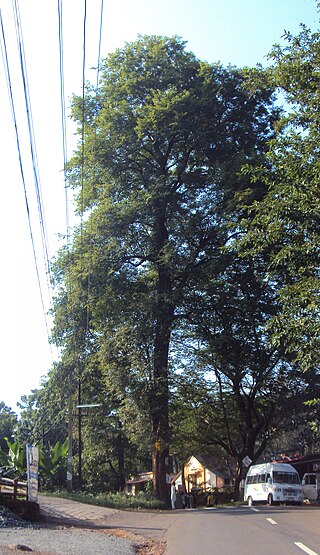Dalbergia latifolia
Species of legume From Wikipedia, the free encyclopedia
Dalbergia latifolia (synonym Dalbergia emarginata) is a premier timber species, also known as the Indian rosewood (Tamil / தமிழ்: Eetti / ஈட்டி) (Telugu / తెలుగు: Irugudu/ ఇరుగుడు). It is native to low-elevation tropical monsoon forests of south east India.[3][1] Some common names in English include rosewood, Bombay blackwood, roseta rosewood, East Indian rosewood, reddish-brown rosewood, Indian palisandre, and Java palisandre.[3][1] Its Indian common names are beete, and satisal or sitsal.[3] The tree grows to 40 metres (130 ft) in height and is evergreen, but locally deciduous in drier subpopulations.[3][1]

| Dalbergia latifolia | |
|---|---|
 | |
| Dalbergia latifolia growing as a street tree in Peravoor, India. | |
| Scientific classification | |
| Kingdom: | Plantae |
| Clade: | Tracheophytes |
| Clade: | Angiosperms |
| Clade: | Eudicots |
| Clade: | Rosids |
| Order: | Fabales |
| Family: | Fabaceae |
| Subfamily: | Faboideae |
| Genus: | Dalbergia |
| Species: | D. latifolia |
| Binomial name | |
| Dalbergia latifolia | |
| Synonyms[2] | |
| |
Description and biology

The tree has grey bark that peels in long fibres, pinnately compound leaves, and bunches of small white flowers.[3] It grows as both an evergreen and a deciduous tree in the deciduous monsoon forests of India making the tree very drought hardy.
Haematonectria haematococca is a fungal pest of the tree, causing damage to the leaves and the heartwood in Javanese plantations.[4] In India, trees may be subject to serious damage from a species of Phytophthora, a water mold genus.[4]
Germplasm resources for D. latifolia are maintained by the Kerala Forest Research Institute in Thrissur, Kerala, India.[4]
Uses

The tree produces a hard, durable, heavy wood that, when properly cured, is durable and resistant to rot and insects.[4] It is grown as a plantation wood in both India and Java, often in dense, single species groves, to produce its highly desirable long straight bore.[4] Wood from the tree is used in premium furniture making and cabinetry, guitar bodies and fretboards, exotic veneers, carvings, boats, skis, and for reforestation.[3][4]
Under the Indian Forest Act, 1927 the exportation of lumber products from wild harvested D. latifolia is illegal.[1] There exists an international high demand and price for the wood due to its excellent qualities of having a long straight bore, its strength, and its high density.[4] However, the tree is slow-growing; Javanese plantations were started in the late nineteenth century, but, due to its slow growth, plantations have not expanded beyond Java and India.[4] Many once popular uses for D. latifolia wood have now been replaced with Dalbergia sissoo wood and engineered rosewoods, for economic purposes in cottage industries.
See also
References
Wikiwand - on
Seamless Wikipedia browsing. On steroids.

